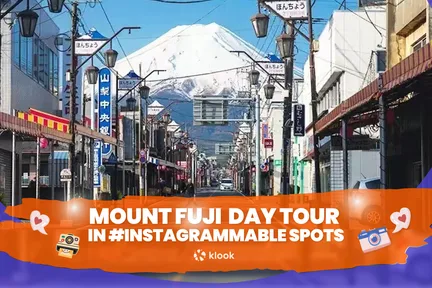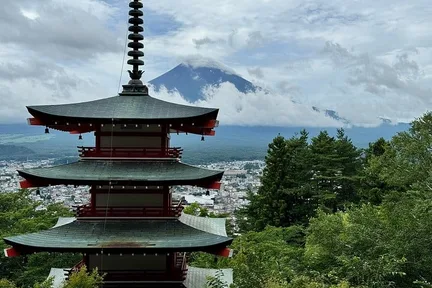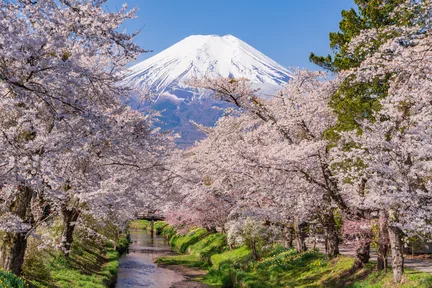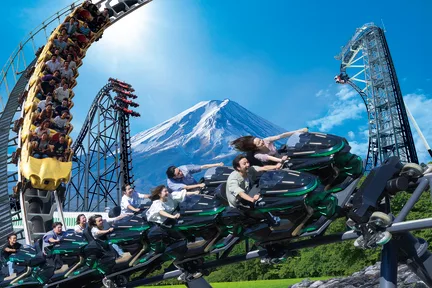Mount Fuji

The best of Mount Fuji
Bucket-list experiences
Make it a getaway
Trouble-free transport
More to explore
Why people love Mount Fuji
Nearby places to go
FAQs about Mount Fuji
Why is Mount Fuji so famous?
Where is Mount Fuji located?
How tall is Mount Fuji in Japan?
Can you see Mt Fuji from Tokyo?
How to get to Mount Fuji from Tokyo?
Can you climb Mount Fuji?
Where to go for the best views of Mount Fuji?
When's the best time to see Mount Fuji?
What to know before visiting Mount Fuji
The Geological Formation Of Mount Fuji
Mount Fuji is an active volcano formed through a series of eruptions over hundreds of thousands of years. The Mount Fuji volcano consists of three overlapping cones---Komitake, Ko fuji (Old Fuji), and Shin fuji (New Fuji), each representing different stages of its geological development. Over time, layers of lava and ash built up to create its symmetrical shape.
Though currently dormant, Mount Fuji erupts periodically, with the last eruption occurring in 1707 during the Edo period. This eruption, known as the Hoei Eruption, covered surrounding areas in ash. Scientists continue to monitor the volcano closely due to its potential for future activity.
Top Locations to View Mount Fuji
Fujiyoshida, Yamanashi Prefecture
At the northern base of Mt Fuji, you'll find the town of Fujiyoshida. It's the closest town to Japan's largest mountain. The city's main street is lined up perfectly with Mount Fuji, giving you the famous view you often see on social media. The shops on the street have traditional Japanese signs, making you feel like you're in a classic Japanese town. While there, visit local cafes and souvenir shops for a full cultural experience.
Lake Kawaguchiko
The northeastern shore of Lake Kawaguchiko gives you an amazing view of Mount Fuji. On days with clear weather, you can even see a reflection of the mountain in the lake. Ride the Mount Fuji Panoramic Ropeway to the top of Mount Tenjo for even more breathtaking sights of the iconic eight peaks. Nearby, don't miss the Kawaguchiko Music Forest, where you can enjoy charming gardens and fun musical attractions, all with great views of Mt Fuji.
Lake Ashi
Lake Ashi in Hakone is famous for its beautiful views and hot spring resorts. From Moto-Hakone, you can see the lake, Mt Fuji, and the red torii gate of Hakone Shrine all at once. You can also hop on fun "pirate ships" that sail across the lake a few times a day.
Mt Tenjo Observation Deck
If you want an amazing view of the sacred mountain, go up Mt Tenjo by Lake Kawaguchiko. There's a lookout point with huge swings that are 3.5 meters high. You can swing and see Mt Fuji at the same time! It's a fantastic place to enjoy the scenery and have a lot of fun.
Fuji-Q Highland
Fuji-Q Highland in Yamanashi is an exciting amusement park famous for its amazing roller coasters. Along with the thrilling rides, you can see beautiful views of snow-covered Mt Fuji in the winter. Some of the roller coasters even give you great views of the mountain while you're zooming around.
Tips For Climbing Mount Fuji
Prepare Physically
The ascent from the 5th Station via the Yoshida Trail takes around six hours on average to reach the summit. Although there is no rock climbing required, a moderate level of fitness is recommended. Many Fuji climbers train in advance with cardio workouts and leg-strengthening exercises to improve endurance and prevent fatigue during the climb.
Pace Yourself and Watch for Altitude Sickness
Climbing too quickly can lead to altitude sickness, which affects both beginners and experienced hikers. Listen to your body, take breaks as needed, and consider staying overnight in a mountain hut to acclimate to the higher altitude before reaching the summit.
Be Aware of Trail Conditions
Mount Fuji has four main trails (Yoshida, Subashiri, Fujinomiya, Gotemba) and each trail presents different challenges. For example, the Yoshida Trail has zigzagging, dusty, and slippery sections, especially during descent. Wearing proper hiking boots and using trekking poles can help maintain stability and reduce the risk of falls.
Respect the Mountain's Cultural and Natural Significance
Mount Fuji is not only a physical challenge but also a sacred site deeply rooted in Japanese culture. Many Japanese climb the mountain as a spiritual journey. Approach the climb with respect, enjoy the breathtaking views, and follow all regulations to help preserve the mountain for future hikers.
Best Spots To See Cherry Blossoms Near Mt Fuji
Chureito Pagoda (Arakura Sengen Shrine)
One of the most breathtaking spots to see cherry blossoms near Mount Fuji, Chureito Pagoda at Arakura Sengen Shrine offers a picture-perfect view. This five-story pagoda, built as a peace memorial, overlooks Fujiyoshida City with Mount Fuji majestically in the background. In spring, delicate sakura blooms frame the pagoda, creating an iconic scene that attracts photographers from around the world.
Fuji Five Lakes Sakura Festival
The Fuji Five Lakes Sakura Festival is one of the most spectacular events for cherry blossom viewing near Mount Fuji. Held annually around Lake Kawaguchi, this festival celebrates sakura season with stunning pink blooms lining the lake's shores, creating a breathtaking contrast against the snow-capped peak of Mount Fuji.
You can enjoy food stalls, cultural performances, and nighttime illuminations, where cherry blossoms glow beautifully under the evening lights. The serene lake provides mirror-like reflections of both the flowers and the mountain, making it a dream spot for photographers.
Oshino Hakkai
A hidden gem near Mount Fuji, Oshino Hakkai is a picturesque traditional village famous for its crystal-clear spring ponds and historic thatched-roof houses. During cherry blossom season, the village transforms into a magical scene as delicate sakura petals frame Mount Fuji in the distance. The peaceful atmosphere, combined with reflections of pink blossoms in the pure spring waters, creates a stunning visual experience.
Stroll through the village, enjoy local snacks, and capture breathtaking views of cherry trees, traditional Japanese architecture, and Fuji's towering peak all in one frame.
Other Things to do at Mt Fuji
Visit the Fujisan World Heritage Center
Check out the Fujisan World Heritage Center, the old Fuji Visitor Center, to learn about the history and culture of Mt Fuji. Here, you'll find the South Hall and North Hall, which have exhibits about the mountain's volcanic activity and its role as an artistic inspiration. You can see how Mount Fuji has influenced Japanese culture through things like woodblock prints and other art pieces.
Visit Fujisan Sengen Shrine
Explore the spiritual side of Mount Fuji by visiting the Fujisan Sengen Shrine. This historic site is dedicated to mountain worship. The shrine helps you understand the cultural importance of Mt Fuji and learn about the traditions and beliefs related to it. It's a great spot to appreciate the spiritual heritage of this special area.
Relax in a Hot Spring (Onsen)
Relax after a day of adventure by soaking in a traditional onsen with views of Mt Fuji. These hot springs are a great way to unwind while enjoying amazing views. The natural minerals in the water help relax tired muscles, making it a refreshing experience. Many onsens also give you a chance to experience Japanese hospitality with delicious local food.
Join a Mount Fuji tour
Joining a Mount Fuji tour is another great way to explore Japan's most famous peak. Guided tours provide expert insights, transportation, and well-planned itineraries, ensuring you see the top attractions without the stress of planning. Some tours even include seasonal highlights, such as cherry blossoms in spring or autumn foliage.
More Places To Visit In Japan
Shirakawa-Go
Located in the mountains of Gifu Prefecture, Shirakawa-Go is a UNESCO World Heritage Site renowned for its traditional gassho-zukuri farmhouses. These iconic thatched-roof houses, designed to withstand heavy snowfalls, create a unique and picturesque village setting. Visitors can explore the village's serene landscapes, visit the Shirakawa-go Gassho-zukuri Minkaen, an open-air museum displaying historic farmhouses, and enjoy stunning views of the Japanese Alps
Hep Five Ferris Wheel
The Hep Five Ferris Wheel is an iconic feature of Osaka's skyline. Standing at 106 meters, this giant Ferris wheel offers stunning views of Osaka and is an unforgettable way to see the city from above. It takes visitors on a gentle ascent, offering panoramic views of Umeda Sky Building, Osaka Castle, and the distant Mount Rokko.
Legoland Discovery Center
Legoland Discovery Center Tokyo is a fun, family-friendly indoor attraction perfect for young children and Lego enthusiasts. Featuring a range of interactive exhibits, this indoor theme park offers visitors the chance to build and play with Lego bricks, explore miniature models of famous Japanese landmarks, and enjoy attractions like the Lego 4D Cinema and Lego Kingdom.




